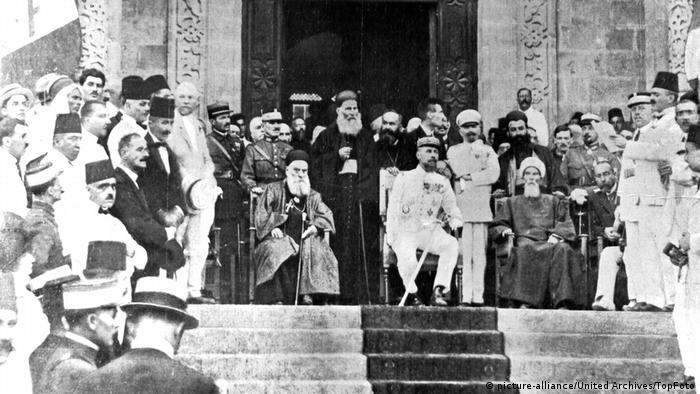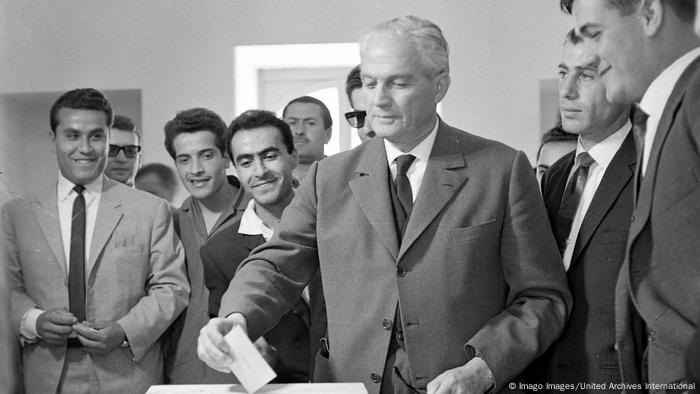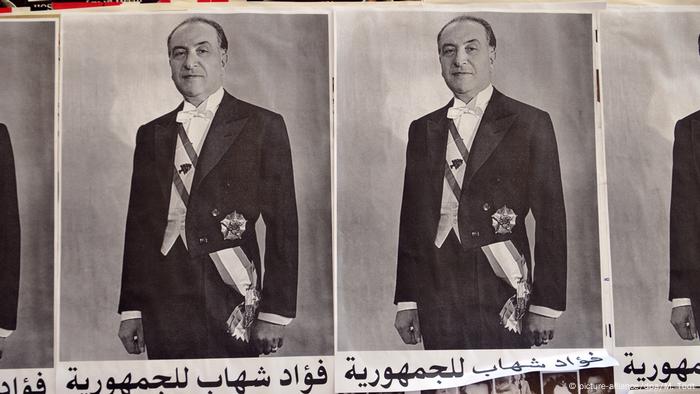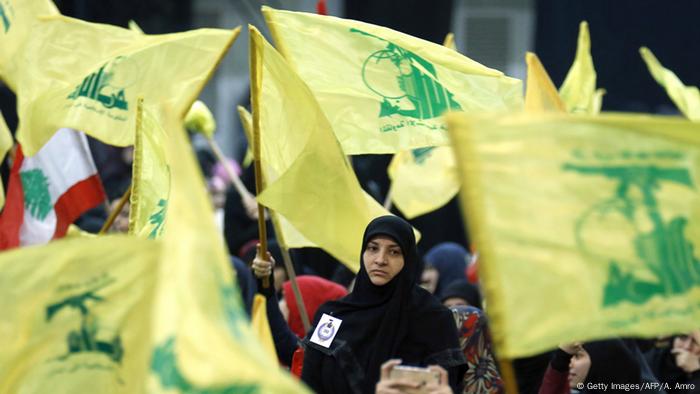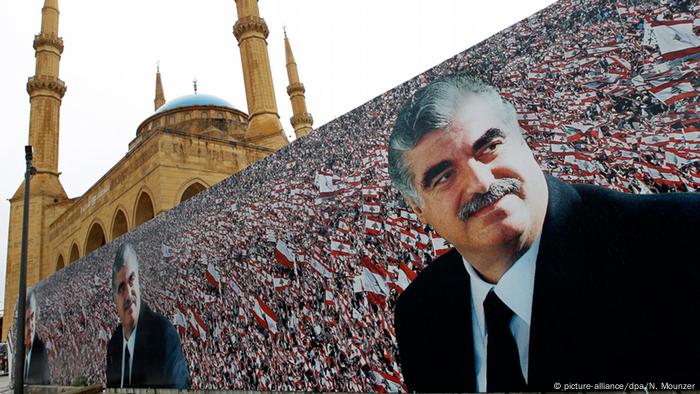Protesters organized a march in the Lebanese capital on Saturday (October 17, 2020) to revive Launch anniversary A protest movement that overthrew the government, but has not yet overthrown the political elite that is in charge of affairs, and the country witnessed during his rule a severe economic crisis and the collapse of the local currency.
The march ended at the entrance to the port of Beirut, where a great flame of the revolution was lit as a greeting to the victims of the explosion in the port of Beirut on August 4, after observing a minute of silence for the lives of the victims. .
At night, clashes broke out in the vicinity of the Parliament and Martyrs’ Square in the center of the Lebanese capital, when a group of protesters threw stones at the security forces, who fired tear gas, according to an AFP photographer.
The protesters highlighted their adherence to their demands represented by a government independent from its president to all its members, early parliamentary elections, implementation of reforms, persecution of the corrupt and thieves, recovery of stolen funds, and trial and accountability of those responsible of the port explosion. And they declared that they are holding the political authority to account and will not stop before the ruling system is overthrown.
The activists called for a civil status and the resignation of the governor of the Banque du Liban after the great collapse of the Lebanese pound. They also demanded not to lift subsidies for basic materials.
It is noteworthy that the protest demonstrations began in Lebanon on October 17, in the center of Beirut, following the government’s decision to impose a tax on the application of “WhatsApp”, which soon spread to all Lebanese regions.
The protesters demanded the formation of a rescue government, the holding of early parliamentary elections, the handling of the economic situation, the recovery of the stolen money, the accountability of the corrupt and an independent judiciary, but for a whole year they did not They were able to meet their demands.
While the unrest led to the resignation of Prime Minister Saad Hariri, politicians have since failed to form a government capable of meeting the country’s challenges. The global epidemic and the August 4 bombing of the port of Beirut, which killed almost 200 people, caused further suffering and the protests lost momentum.
AJM / p. (Reuters, AFP, DPA)
-
Lebanon turns 100 … from the sects of the mountains to a country on the brink of collapse
Sedition of Mount Lebanon
Various sects inhabited the areas known today as Lebanon, especially the Mount Lebanon region. But the most prominent sects were six: Maronites, Orthodox and Catholics, and on the other side the Druze, Sunnis and Shiites. The mountain remained under the control of the Ottomans, but witnessed severe sectarian tensions, especially the massacres between the Druze and Maronites in 1860. European powers intervened in the region, especially France, and Mount Lebanon, under European pressure, witnessed of the establishment of the “mutasarrifiyya” system, which strengthened the Maronite presence.
-
Lebanon turns 100 … from mountain sects to a state on the brink of collapse
The rise of Greater Lebanon
After the defeat of the Ottomans in World War I, France was able to impose its mandate on Lebanon after its expansion to include the Bekaa and the State of Beirut, in addition to delimiting the borders with Syria. Joseph Bahout says in an article on Carnegie that France aimed to create a quasi-national home for Christians in the Middle East, but Muslim sects vehemently rejected the new situation. Lebanon declared its independence in 1943 at the hands of President Bechara El-Khoury, but the evacuation of French forces did not occur until 1946.
-
Lebanon turns 100 … from mountain sects to a country on the brink of collapse
The National Charter
Lebanon’s declaration of independence witnessed what is known as the National Pact, which gave the presidency of the state to the Maronites, the post of prime minister to the Sunnis, and the presidency of Parliament to the Shiites. The purpose of the letter was to facilitate independence, so that Christians would not ask for the protection of France and Muslims would not demand unity with Syria. The letter was not drafted, but it has remained in use in the country ever since, and observers believe it caused the sectarian problems in the country as it was the basis of the quota system.
-
Lebanon turns 100 … from the sects of the mountains to a country on the brink of collapse
Ending Shamon’s rule
Beirut has become a city that unites everyone since the years of independence, but the outbreak of the Arab-Israeli conflict cast a shadow over a country struggling to create its identity. Beirut welcomed thousands of Palestinian refugees, as well as Arab immigrants, and witnessed economic growth, but at the same time, warring Arab powers have focused their influence on the city ever since. However, the most prominent event that Beirut witnessed in the 1950s was the uprising against President Camille Chamoun, who had strong ties to the West.
-
Lebanon turns 100 … from mountain sects to a state on the brink of collapse
The Shehab era
Among Lebanon’s most respected presidents is Fouad Chehab, who ruled the country from 1958 to 1964 and rejected an extension despite his overwhelming popularity. During Shehab’s reign, much stability was achieved in the country, despite criticism directed at him by strengthening the role of the intelligence services after the coup attempt. Then came Charles Helou, who tried to follow Shehabi’s approach by not preferring any political party over another, but the country witnessed various economic problems during his reign, which paved the way for Suleiman Franjieh to succeed him.
-
Lebanon turns 100 … from the sects of the mountains to a country on the brink of collapse
Civil war breaks out
Lebanon witnessed the signing of the Cairo Agreement in 1969 between the Palestinian factions in the refugee camps and the Lebanese state, so as not to repeat skirmishes between the two parties, according to which the Palestinian armed presence in Lebanon was recognized. The Lebanese left supported the Palestinians, while the right, which was made up mainly of Maronite organizations, rejected them. With the rise of Palestinian influence, frictions with the right-wing forces multiplied and civil war officially broke out in April 1975.
-
Lebanon turns 100 … from the sects of the mountains to a country on the brink of collapse
Beirut is on fire
Beirut was divided into the east, under the control of right-wing forces, and the west by Palestinians and left-wing forces. The sectarian rivalry between Muslims and Christians increased the war, especially with the social imbalances between them. The Syrian intervention increased the price of the war, as did Israel when it invaded Lebanon in 1982 and besieged West Beirut, prompting the evacuation of Palestinian militants, but the war did not end, and after that, clashes even broke out. within the allied parties.
-
Lebanon turns 100 … from mountain sects to a country on the brink of collapse
Hezbollah is victorious
The war officially ended in 1991, two years after the signing of the Taif Agreement. The war saw horrible massacres such as those of Karantina, Damour, Sabra and Shatila, and cameras documented horrible scenes such as the siege of Beirut and the war in the countryside. Subsequently, the Shiite organizations were strengthened, especially Hezbollah, which is linked to Iran, and the organization kept its weapons after the dissolution of all the militias, so the influence of the armed organizations of the right, left and Palestinian declined, and Syria ensured its continued presence in the country.
-
Lebanon turns 100 … from mountain sects to a country on the brink of collapse
The murders continue
Lebanon was relatively stable in the 1990s, but the millennium years saw armed clashes between Hezbollah and Israel in the summer of 2006, but the most violent earthquake was the assassination of Rafik Hariri, the former prime minister who contributed to the reconstruction of Lebanon. One of the results of the assassination was the departure of Syrian forces as a result of what became known as the “Cedar Revolution”. In those years, the country witnessed the continuation of political assassinations in which accusations were leveled against Damascus, such as the murder of communist George Hawi and journalist Samir Kassir.
-
Lebanon turns 100 … from mountain sects to a state on the brink of collapse
The Lebanon movement
For the first time in the country’s history, hundreds of thousands of Lebanese will come out in 2019 to reject the sectarian quota system, demanding the departure of the political class as a whole. The protests came against the continuing deterioration of the economic situation and high rates of corruption, which led to the resignation of the Saad Hariri government and the formation of the Hassan Diab government, who in turn resigned following the bombing in the Beirut port, which killed nearly two hundred people. Report: Ismail Azzam
Writer: Ismail Azzam


